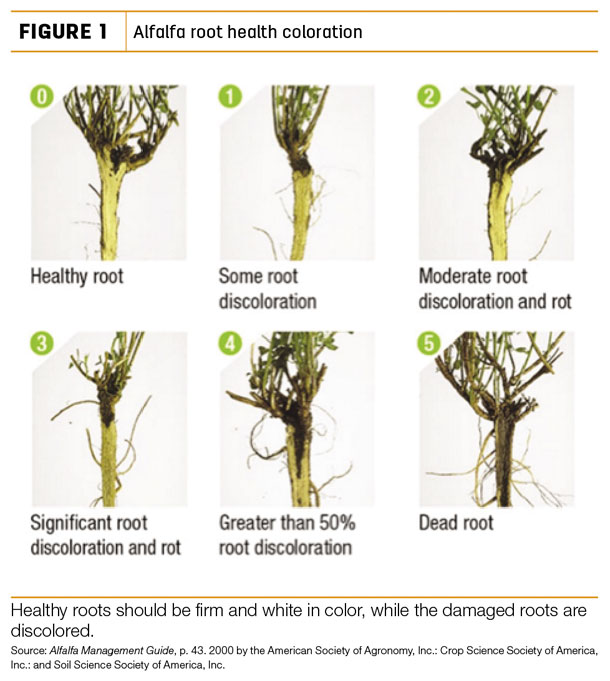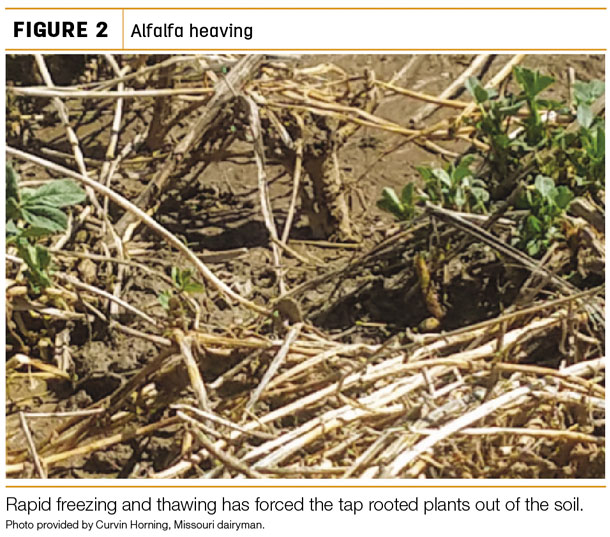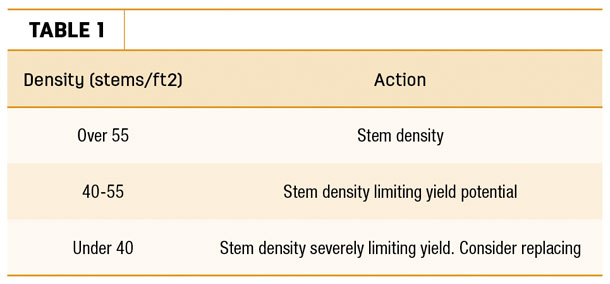Typically, alfalfa plants can tolerate up to three weeks of winter injury before plants die. This window of time can vary due to soil temperatures, with the window being smaller if soils are frozen and larger if soils are already at a higher temperature.
We cannot control the weather. We can, however, reduce the risk of winter injury through variety selection, maintaining young stands, potassium fertilization, proper pH, soil drainage, snow retention and timely cutting management. In the event of a tough winter, remember to diagnose the potential injury, determine the yield potential and establish a game plan.
Factors that can affect alfalfa plant hardiness
-
Stand age: Older stands are more likely to winterkill than younger stands.
-
Soil pH: Soils with a pH above 6.6 are less likely to experience winter injury.
-
Soil fertility: Stands planted with high natural fertility are less likely to experience winter injury than those with low fertility.
-
Variety: Alfalfa varieties with superior winter hardiness ratings and a high disease resistance index are less likely to experience winter injury.
-
Cutting management: Harvest frequency and timing of fall cutting will affect alfalfa winter hardiness. Stands in which the last cutting is taken between Sept. 1 and the middle of October are at greatest risk as plants have not had enough time to accumulate carbohydrate levels in the root system before winter.
- Snow cover: Snow provides insulation to the plants and the crown. The crucial temperature region is 2 to 4 inches below the soil surface where a large part of the root structure is located. Stands that have at least 6 inches of stubble left will be able to retain more snow cover and be less susceptible to winter injury.
How to diagnose winter injury
-
Stands which are slow to green up: Compare your stand to other fields in the area. If you notice great variation in your field with some green up and some areas still brown, it is time to further investigate the brown stands for injury or death.
-
Winter-killed roots have a gray appearance: Healthy roots should be firm and white in color as shown in Figure 1. If the root is soft and darker, it is a possible sign of winter cold-related death.

-
Asymmetrical or uneven growth: If asymmetrical growth is observed, a portion of the plant was likely winter-killed, and only the healthy portion will be productive. If uneven growth is observed, a portion of the buds that were developed during the previous fall were likely injured, and it will take time for those new buds to form, thus resulting in shoots of different heights on the same plant.
-
Heaving: During heaving, alfalfa crowns and roots are forced above the surface of the soil as a result of freezing and thawing. Heaving occurs more commonly in heavy soils that feature a high moisture content. Repeated freezing and thawing causes soil expansion and contraction, which pushes the taprooted plants out of the soil (Figure 2) in late winter and/or early spring. Due to their more developed taproot, older alfalfa stands are more prone to heaving compared to grasses or first-year alfalfa stands, which have more fibrous root systems.

Determine yield potential
Potential yield of an alfalfa field stand may be estimated by determining the number of stems in a square foot area. Once stem number is determined, use the following formula to calculate yield potential of that stand:
Yield (tons per acre) = (Stems per square foot x 0.1) + 0.38
Example: An alfalfa field with 50 stems per square foot would have a yield potential of 5.38 tons per acre. Remember, this is potential yield. Soil factors, nutrient deficiency, insects, diseases and many other things may affect the actual yield. The following guidelines can be used to help decide whether to keep or replace the alfalfa stand (Table 1).
Be prepared
It is important to establish a plan to ensure an adequate forage inventory for the coming year in case your fields experience winterkill or severe heaving. If heaving is confined to patches in the field, consider renovating the stand by reseeding the affected patches. If moderate heaving allows you to keep the field for more than one year, consider planting red clover or a mixture of red clover and grass to ensure an adequate forage yield.
If your goal is to maintain the field this growing season, and if additional legume yield is desired, consider berseem clover, crimson clover or even field or forage peas, depending on the ratio of seed cost to potential yield. But remember, when another grass or legume is patched into an existing stand, the newly-seeded area will need time – often a minimum of 60 days after planting – to become established prior to harvest.
If severe heaving or winterkill takes place and the alfalfa stand is terminated but additional forage is required, other options include warm-season sorghum-sudangrass and/or their basal metabolic ration (BMR) variety counterparts, which can be planted and harvested within a 50- to 60-day window, followed by subsequent harvests every 30 days into the fall (in optimal growing conditions). Other cool-season grass options for filling forage inventories include spring cereal grains such as oats, barley, triticale and Italian ryegrass.
Quality forage is a critical component of a dairy herd’s nutrition program. To be adequately prepared for a damaged alfalfa crop or – in the worst case scenario, an alfalfa crop that is considered a complete loss – it is essential to understand your options and have a backup plan in place. ![]()

-
Jon Pretz
- Dairy Nutritionist
- Hubbard Feeds
- Email Jon Pretz











